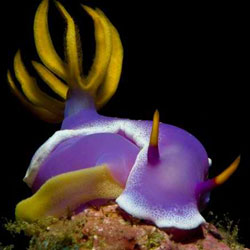 This site is located just 10 minutes away from our Dive Center making it a easily accessible all around dive site. The site is fairly shallow with a wall that drops to about 20 meters, and is normally visited for night dives since most of the wreck sites are closed for this type of diving.
This site is located just 10 minutes away from our Dive Center making it a easily accessible all around dive site. The site is fairly shallow with a wall that drops to about 20 meters, and is normally visited for night dives since most of the wreck sites are closed for this type of diving.
When diving at the Lighthouse site you’re likely to see different types of Coral Fish, Crabs, Banded Coral Shrimp, Cuttle Fish and a wide variety of Nudibranch. The site is commonly used for less experienced divers (used as a training site) but also accommodates the more advance diver. The site got its name from local fishermen who commonly mistake the marker light on the radio beacon tower for a light house.
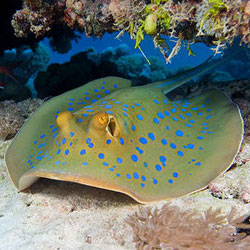 This site is located right at the East end of the Runway and is one of the coral reef sites within Subic Bay. This dive site is commonly used as training ground for less experienced divers but also considered as a fun dive amongst more experienced divers. The site offers a drop-off wall starting at a depth of approximately 5 meters, and continues down below 20 meters, with the major part of the reef between 9-18 meters.
This site is located right at the East end of the Runway and is one of the coral reef sites within Subic Bay. This dive site is commonly used as training ground for less experienced divers but also considered as a fun dive amongst more experienced divers. The site offers a drop-off wall starting at a depth of approximately 5 meters, and continues down below 20 meters, with the major part of the reef between 9-18 meters.
This reef is mostly made up of hard coral types with a frequent presence of both Sea Whips and Sea Anemones. The corals are home to a wide variety of Reef fish species. Bluespotted Stingrays and Pufferfish are very common at this site. Waters here are usually clear, making this dive site good for underwater photography and a regular dive spot for our Scuba Diver and Open Water Diver courses.
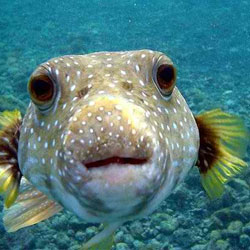 This dive site is considered as the second best coral reef site within Subic Bay. Nabasan Reef is located at the South-West part of Triboa Bay and is often used as a training ground for less experienced divers. The site offers a drop-off wall starting at a depth of approximately 4 meters, and continues down past 20 meters, with the major part of the reef between 6-17 meters.
This dive site is considered as the second best coral reef site within Subic Bay. Nabasan Reef is located at the South-West part of Triboa Bay and is often used as a training ground for less experienced divers. The site offers a drop-off wall starting at a depth of approximately 4 meters, and continues down past 20 meters, with the major part of the reef between 6-17 meters.
This reef is mostly made up of hard coral types with a frequent presence of both Sea Whips and Sea Anemones. The corals are home to a wide variety of Reef fish species. Bluespotted Stingrays and Pufferfish are also common at this site. Waters here are usually clear, making this dive site good for underwater photography and a regular dive spot for our Discover Scuba Diver and Open Water Diver courses.
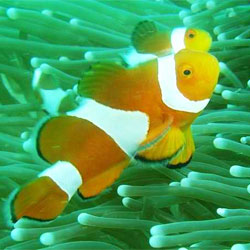 The Canyons Reef is located just South-West of Grande Island. This dive site differs quite a lot from the regular wreck diving sites scattered throughout the bay, offering great visibility (up to 15 meters), lots of corals and beautiful rock formations to explore. The site can be compared with other reef sites in the Philippines and is a great dive site for the less experienced diver.
The Canyons Reef is located just South-West of Grande Island. This dive site differs quite a lot from the regular wreck diving sites scattered throughout the bay, offering great visibility (up to 15 meters), lots of corals and beautiful rock formations to explore. The site can be compared with other reef sites in the Philippines and is a great dive site for the less experienced diver.
You don’t have to go far or deep before you come across stunning coral reefs scattered around the sea bed, often surrounded by different types of marine life. The most commonly spotted fish at this site are Clownfish, Nudibranch, Grouper, Lionfish, Pufferfish, Jackfish, Parrotfish, Pipefish, Batfish and Frogfish. Divers have occasionally reported to spot both schools of Cuttlefish, Octopus and Shark.
The reef has many fairly shallow spots, some as shallow as 15 feet, and is therefor commonly visited by less experienced divers or divers conducting their dive training. The Canyons Reef is a great site for snorkeling sessions depending on the tides. If you continue heading towards the Southern end, it gets deeper again. With the currents a bit stronger, this is ideal for a drift dive. As an experienced diver this change of pace will offer no problems, but those who are just starting out would do well to stick to the shallower parts and not go too deep. Even if you don’t go deep there are several fish species and clams to observe.
This is definitely a “must visit” site in case you’re diving with us here in Subic Bay, a nice break from the far more advanced wreck diving sites with lower visibility and less marine life.
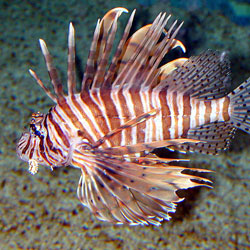 The “Barges” is one of the easier and more relaxed dive sites within the Subic Bay area, located just outside the north-west shore of Grande Island. The name of the dive site derives from the large number of pontoons that were put here by the American Forces. The barges and pontoons are scattered around the area divided into sections.
The “Barges” is one of the easier and more relaxed dive sites within the Subic Bay area, located just outside the north-west shore of Grande Island. The name of the dive site derives from the large number of pontoons that were put here by the American Forces. The barges and pontoons are scattered around the area divided into sections.
The site offers diving for both beginners and advanced divers, with fairly good visibility for being Subic Bay and plenty of marine life. Some of the most common fish types you will see at this site are the Garden eels, Pipefish, Lionfish, Nudibranch, Sea cucumbers, Bluespotted Stingrays, Grouper’s, Clownfish and Pufferfish. The flow of the aquatic life forms are continuous so most of the times there are several of each species to behold. Sometimes divers have spotted schools of Tunafish at the site but in general this is not very common.
The actual barges sections are separated and set apart with the first section about 40 meters north of Grande Island’s west end, at a depth of about 6 meters. The next section is about 20 meters away and sits at approximately 10 meters of water. The site forms a rough letter “T” with the right portion of the “T” dropping off to 32 meters and the left part at a depth of 18 meters. The dive site is considered as a “good all around site” offering plenty of marine life combined with easy and fun penetration possibilities.
We recommend this site for Photography dives, Discovery dives and Night diving. The site is often used for dive training due to its diverse characteristics. The shallowness makes it easy to swim in so its a great training ground for beginners. If you take diving lessons or if you’re interested in a Discovery Scuba session this is likely to be one of the places you will visit to familiarize yourself with the underwater world. Its also a great place for you who hasn’t been diving for a while in order to freshen up on your skills.
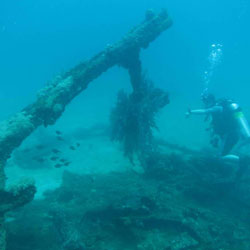 Diving Information:
Diving Information:
Located at the eastern entrance of Subic Bay Philippines ( southeast of Chiquita Island and Grande island), is the historic wreck of the Spanish Gun Boat, the San Quentin (aka The Sunken Tin). The fascinating San Quentin Subic wreck rests in 16 meters of water, allowing divers of all levels to explore what still remains of a ship that was scuttled in 1898 to block access to the bay from the invading American Navy.
Visibility is usually around 15-20 meters depending on the tides, making this site excellent for photography. The marine life at the site is diverse and your likely to see Moray Eel, Lobster, Bluespotted Stingray, Batfish, up to 20 different types of Nudibranch, Octopus, Jackfish, Giant Clam, plenty of Corals and Sponges. Further North of the wreck is a shallow reef about 6 to 10 meters deep. The relative shallowness of the San Quentin wreck makes this a great dive site for beginners.
Wreck History:
This vessel is situated in Triboa Bay close to the end of the runway, lies on the edge of a reef with its starboard side lower. Depth is 10-21 meters (35-75 feet) with visibility from 10-16 meters (30-50 feet). It was used during second world war for transport of heavy hardware and infantry. The reason and the date of sinking are unknown.
The Giant Clams found at this site were introduced by the University of the Philippines through a special project conducted back in 1999.
- Depth: 9-22 m / 30-75 ft
- Average Visibility: Variable 3 - 7m / 10 - 23 ft
- Recommended Diver Certification: Open Water
- Recommended EAN Blend: 36 (1.4 pO2)
Wreck History:
The Landing Craft Utility (LCU) is a type of boat used by amphibious forces to transport equipment and troops to the shore. They are capable of transporting tracked or wheeled vehicles and troops from amphibious assault ships to beachheads or piers. These vessels have bow ramps for onload/offload. This particular model has three engines enclosed in separate watertight compartments. LCU's were used extensively in WW2 in both theaters.
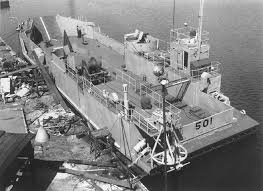
Diving Information:
This vessel is situated in Triboa Bay close to the end of the runway, and lies on the edge of a reef with its starboard side lower. It is believed to have sunk in a storm after then end of WW2. The depth is 10-21 meters (35-75 feet) with visibility from 3-8 meters. The port side of the LCU is about 10 meters deep and the entire dive site is suitable for both beginners and more advance divers.
The wreck has large open areas. Diving is very relaxed with good fish life. The small rooms on the deck are a great introduction to wreck diving and superb for side mount training. The wreck is easy to navigate and possible without specialized equipment or training. This is a great dive for underwater photographers.
The wreck is home to a collection of different lionfish species, along with schools of jackfish, barracuda and various reef fish. In the surrounding rock & sand reef we occasionally see stingrays, octopus, cuddlefish and the occasional turtle. There are two gun platforms at the mid-section and several rooms that offer short penetrations towards the rear. The vessel is intact and it is easy to gain a comprehensive appreciation of her features in a single dive.
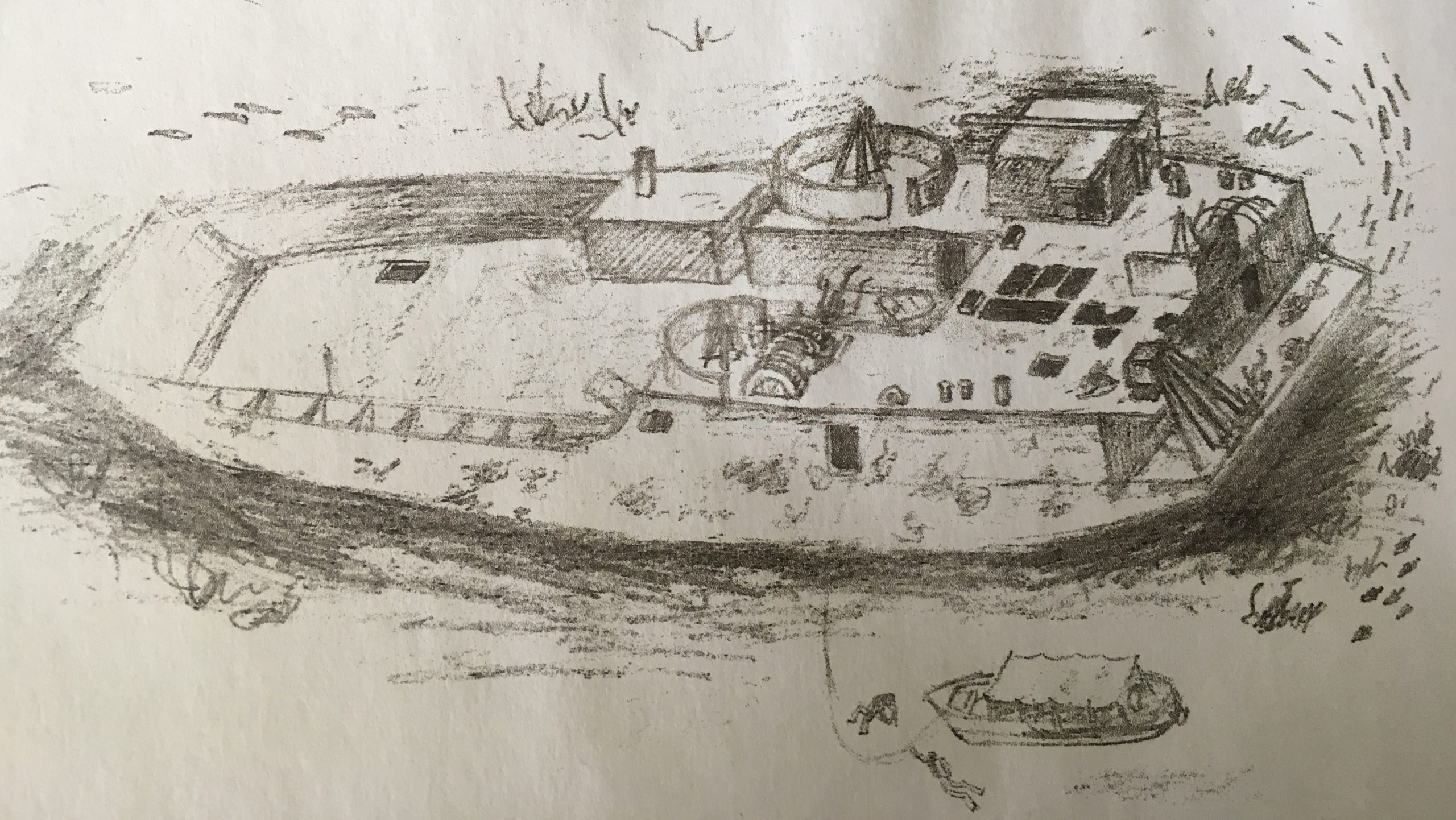

Diving Information:
At a depth of slightly over 18 meters the outside of the wreck provides an excellent site for divers. The forward hole is wide-open allowing entry by even novice divers. The top side (starboard side) is at 5 meters, which eliminates the need for an additional safety stop. This area is alive with a wide variety of fish. From the forward hole, additional areas of the ship may be accessed. One route takes you to the accommodation area and on to rear cargo hold.
She is approximately 3,000 t., 80 meters long and structurally intact. Divers can enjoy swimming inside her massive forward and rear holds and if properly trained and equipped, enjoy comparatively safe penetration into her cavernous boiler room. The combination of good visibility, shallow depth, no current and intact structure makes this wreck an ideal starting point for the novice wreck diver.
Wreck History:
Normally referred to as the El Capitan the USS Majaba (AG 43) was built as SS Meriden by Albina Engine & Machine Works, Portland, Oreg., in 1919; acquired by the Navy under charter as SS El Capitan from her owner, E. K. Wood Lumber Co., of San Francisco, Calif., 23 April 1942; renamed Majaba and commissioned the same day. She was placed out of service 14 March 1946 at Subic Bay.
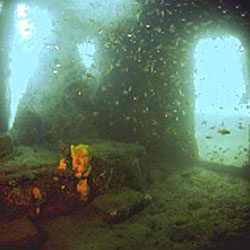 Diving Information:
Diving Information:
This vessel is situated in a depth of 18 - 25 meters (60-75 feet). Sitting upright. The wreck is a great dive with average visibility from 7-13 meters (20-40 feet). Plenty of marine life is located around the whole wreck. The compartments provide shelter for many schools for juvenile fish. Buoy attached at the bow.
Part of the attraction there now, besides the wreckage, include the various corals that have sprung up, adding color and vibrancy to the scene. There are also several kinds of fish such as Jackfish, Trout and different types of Lionfish. The currents are not very strong in the area but do appear at times, and can reduce the visibility dramatically. Beginners who wish to explore this dive site should have an experienced Divemaster to accompany them at all times.
Wreck History:
Generally called the Japanese patrol boat this ship has not been fully identified as to name or even type. About 105 feet long and 18 feet wide, a trawler style vessel, possibly a 150-ton tugboat or a Submarine chaser. It sank 1944 or 1945 most likely because of fire after explosion onboard. Details about the reason of the explosion are unknown.
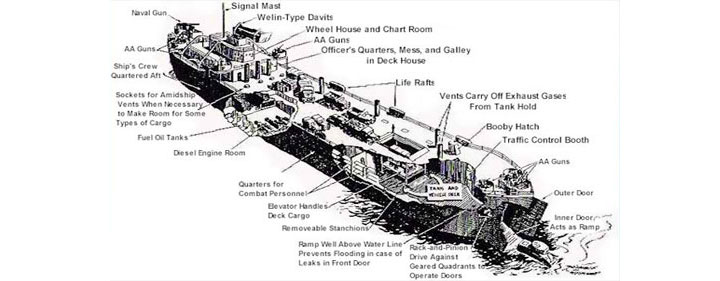
Diving Information:
This wreck is often used in dive training for deep and wreck diving. At about 34 meters to the bottom of the wreck it a good area to test Nitrogen narcosis reaction. As a tool for wreck training the ship offers an overhead environment free of entanglements and unobstructed view of the exits. After a brief tour of the hold, divers can explore the deck area. There is also a school of barracudas living permanently next to the wreck. Many Divers claim to have seen bull sharks in the vicinity.
Wreck History:
The LST, for "Landing Ship, Tank" was created during World War II to support amphibious operations by carrying significant quantities of vehicles, cargo, and troops directly onto an unimproved shore. Over 50 LST’s were sold for scrape or for commercial use at Subic. As many as 10 may have been used for target practice or just sunk at Subic Bay perimeter. It is impossible to say which ships where brought to Subic, once a ship was stricken from the roles or decommissioned it was no longer tracked by its hull number.
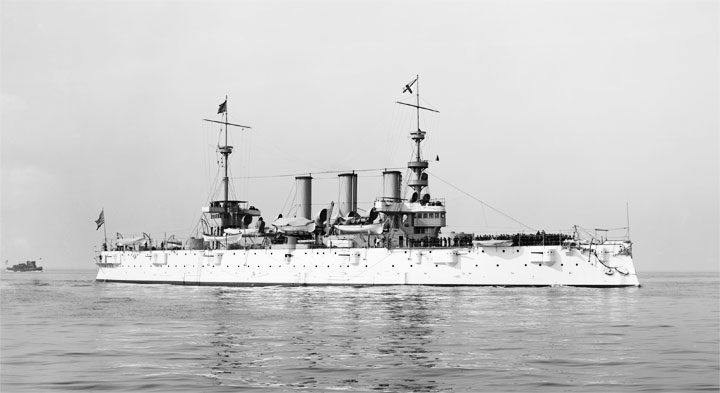
- Depth: 16-30 m / 55-100 ft
- Length: 117 m / 384 ft
- Average Visibility: Variable based on harbor movement
- Recommended Diver Certification: Advanced
- Recommended EAN Blend: 36 (1.4 pO2)
Our most requested wreck dive and one of the most historically interesting.
History
The USS New York was launched in the 1890's as the US Navy's 2nd armored cruiser and with six 8-inch guns was the most heavily armed. She was later named the Saratoga and then the Rochester. She saw service in the Spanish American War, and WW1 and was decommissioned in 1933. In 1941 she was scuttled in the Subic Bay harbor to keep her out of the hands of the advancing Japanese.
Diving Information:
The New York is located within the inner harbor at Subic Bay. She lays on her port side with her big guns and their turrets fully intact and visible. Also visible is one of her giant propellers. A large portion of her mid-section is rather mangled up to do to flattening by the US Navy in the late 60's to allow deeper ships into the harbor. Another fascinating part of this wreck is her general structure and design. With curved windows/gun ports, propeller on a shaft and her bow structure, this really gives you a glimpse of the late 1800's in ship design.
- Advanced Divers – More advanced divers can explore the propeller, conning tower and deck areas and see the big guns. The mess deck has an interesting swim of 60 meters (197 ft.) with portholes above allowing light to enter the spaces, but no exit.
- Wreck Divers – There are some other areas for the experienced wreck diver. The boiler room can be explored on a single tank. We offer both Wreck Diver Courses and Advanced Wreck Diver Courses conducted on all of the wrecks within Subic Bay. The courses are held on a one-to-one basis but can also be done in groups of two students and one instructor.
- Advanced Wreck Divers – Those who can dive beyond recreational limits can access the engine room and machinery spaces. These are in excellent condition, with huge pipes, machinery and valve wheels. Penetration is generally made on twin tanks, with reel and advanced wreck diver training. Both engine room entrances are posted with notices warning of the dangers to the untrained.
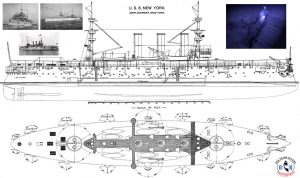
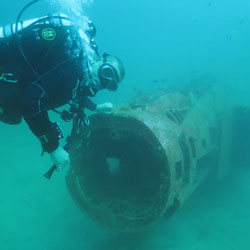 This F-4 Phantom Supersonic Fighter-Jet most likely served with the U.S. Navy and is probably an F-4B, J or N model. The Phantom’s intact condition and various missing components suggest it didn’t crash or ditch. During the Vietnam War it wasn’t uncommon for badly damaged aircrafts to be stripped for parts and, in some cases, even pushed overboard to free up space.
This F-4 Phantom Supersonic Fighter-Jet most likely served with the U.S. Navy and is probably an F-4B, J or N model. The Phantom’s intact condition and various missing components suggest it didn’t crash or ditch. During the Vietnam War it wasn’t uncommon for badly damaged aircrafts to be stripped for parts and, in some cases, even pushed overboard to free up space.
The F-4 Phantom Jet dive site is located just outside the mouth, South of Subic Bay. The site contains the remains (basically only the airframe) of the aircraft, and its believed that the plane was stripped of all mechanical and electrical parts before being pushed off a US aircraft carrier sometime during the Vietnam War. This wreck is located at a depth of 44-45 meters so you’re required to hold at least Tec-45 before conducting a dive with us at this site.
The McDonnell Douglas F-4 Phantom is a tandem two-seat, twin-engined, all-weather, long-range supersonic jet interceptor fighter/fighter-bomber originally developed for the U.S. Navy by McDonnell Aircraft. Proving highly adaptable, it became a major part of the air wings of the United States Navy, Marine Corps, and Air Force. It was used extensively by all three of these services during the Vietnam War, serving as the principal air superiority fighter for both the Navy and Air Force, as well as being important in the ground-attack and reconnaissance roles by the close of U.S. involvement in the war.
The McDonnell Douglas F-4 Phantom is a tandem two-seat, twin-engined, all-weather, long-range supersonic jet interceptor fighter/fighter-bomber originally developed for the United States Navy by McDonnell Aircraft. It first entered service in 1960 with the U.S. Navy. Proving highly adaptable, it was also adopted by the U.S. Marine Corps and the U.S. Air Force, and by the mid-1960s had become a major part of their respective air wings. The Phantom is a large fighter with a top speed of over Mach 2.2. It can carry over 18,000 pounds (8,400 kg) of weapons on nine external hard-points, including air-to-air and air-to-ground missiles, and various bombs. The F-4, like other interceptors of its time, was designed without an internal cannon, but later models incorporated a M61 Vulcan rotary cannon. Beginning in 1959, it set 15 world records, including an absolute speed record, and an absolute altitude record.
The F-4 was used extensively during the Vietnam War, serving as the principal air superiority fighter for both the Navy and Air Force, as well as being important in the ground-attack and reconnaissance roles by the close of U.S. involvement in the war. The Phantom has the distinction of being the last U.S. fighter flown to attain ace status in the 20th century. During the Vietnam War, the USAF had one pilot and two weapon systems officers (WSOs), and the US Navy one pilot and one radar intercept officer (RIO), achieve five aerial kills against other enemy fighter aircraft and become aces in air-to-air combat. The F-4 continued to form a major part of U.S. military air power throughout the 1970s and 1980s, being gradually replaced by more modern aircraft such as the F-15 Eagle and F-16 in the U.S. Air Force; the Grumman F-14 Tomcat and F/A-18 Hornet in the U.S. Navy; and the F/A-18 in the U.S. Marine Corps.
- Depth: 54m / 180 ft
- Average Visibility: Variable 3 - 7m / 10 - 23 ft
- Recommended Diver Certification: Technical Deep
The Banshu Maru No. 52 is an IJN Auxiliary Minesweeper which struck a mine and sank in Subic Bay on January 20, 1942 not long after the Bay was abandoned by the Allies.
She is resting at a depth of 54m(180 ft) in the channel just west of Grande Island. This vessel is fairly small (only 50 meters long) compared to most other wrecks within the bay, nevertheless a very interesting dive site.
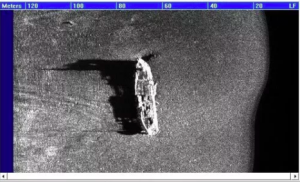
- Depth: 34 -36 m / 112-120 ft
- Average Visibility: Variable 3 - 7m / 10 - 23 ft
- Recommended Diver Certification: AOW/Deep
- Recommended EAN Blend: (1.4 pO2)
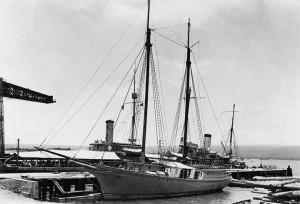
Wreck History:
A movie star, a spy and a war hero all rolled into one. The USS Lanikai was purchase by the US Navy just days before the attack on Pearl Harbor. Hastily fitted with a Spanish American war gun, a WWI Lewis machine-gun and assigned a Naval officer she met the definition of a Navy warship. Her then secret orders were to go follow the Japanese Navy off the coast of Thailand. Historians believe that the intent of this seemly unmilitary craft’s mission was to get the Japanese to sink an American Warship to hasten the US entry into the war. Much like the battleship Maine during the events leading to the Spanish American war. The attack on Pearl Harbor aborted her mission. In her pre-war days she was the star in a movie titled “The Hurricane”. She sank in 1945 during a typhoon (a pacific hurricane) while waiting for repairs.
Diving Information:
Today the remaining of the USS Lanikai lies scattered at a depth of approximately 34-36 meters. Some parts of the structure still remain yet most of it has been claimed by the sea. The site accommodates a wide variety of marine life but due to the depth and how scattered it is, it is rarely visited by the local diving community.
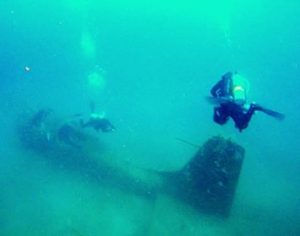
Diving Information
Located just off of Cubi Point at 36m the Douglas Skyraider sits flying across the seabed. Remarkably the plane is still intact, in one piece and just missing the engine and cockpit cowling. You can still see the instruments, the seating, radios and there is even a parachute pack in the aft section. Hover over the wreck and you can see the entire plane, including the wings with their 20mm cannons. Look under the wings and you can see the aircraft's hard points. All in all it is an amazing dive and an amazing sight.
The Skyraider is home to a variety of different fish and is guarded by an ever increasing army of banded shrimp.
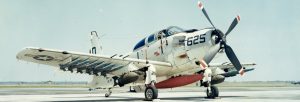
Wreck History
The Douglas Skyraider was an American attack aircraft produced in the late 1940's and saw service in the Korean and Vietnam wars and even was used up until the early 1980's. The Skyraider was produced in numerous variants with from 1 to 4 seating. It is believed that this Skyraider is the AD-5Q (EA-1F) Four-seat electronics countermeasures version.
This aircraft is believed to have crashed into Subic Bay on January 9, 1962 and was from the USS Lexington CV-16. All four crew members were killed.
- Depth: 37 m / 121 ft
- Average Visibility: Variable 3 - 7m / 10 - 23 ft
- Recommended Diver Certification: AOW/Deep
- Recommended EAN Blend: 30 (1.4 pO2)
Wreck History
The M3-Half-Tracks (M3 Gun Motor Carriage Half-Track Tank Destroyer) were tracked American armored personnel carriers widely used in WW2 and first used to contend with the Japanese invasion in the Philippines. It is estimated that there are over 50,000 variants. The Subic M-3's feature a 75mm Howitzer cannon used as a anti-tank weapon and supported armor piercing as well as high explosive projectiles. The M-3 had a crew of 5, including a driver, commander, gunner and 2 ammunition handlers.
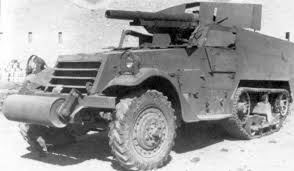
Diving Information
Your guess is as good as ours as to why they are there, but a general thought is that they were dumped off the back of an LCU or barge to keep them out of Japanese hands. However, that brings up even more questions as to why the guns are pointed upwards and why there is still live 75mm ammo at the ready?
This is a fun dive, especially as you decend and the two vehicles come into view. You swim around one, then the other and all of a sudden, it is time to leave. The questions as to "why" they are there entering your mind as you ascent. The M3's boast a variety of fish, including some octopus and a protective army of banded shrimp.
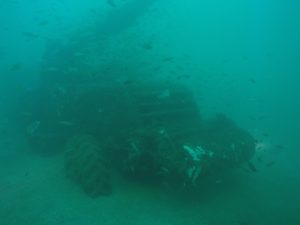
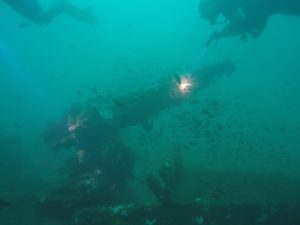
- Depth: 36m / 120 ft
- Average Visibility: Variable 3 - 7m / 10 - 23 ft
- Recommended Diver Certification: AOW/Deep
- Recommended EAN Blend: 30 (1.4 pO2)
We don't have a lot of information on this wreck. It is another Landing Craft Utility sunk right at the entrance to the bay off of the Canyons Reef. Typically the visibility is pretty good. The wreck has sunk into the sand a bit and the superstructure has also collapsed over time, however all three props are still intact and visible. This wreck it is home to a large quantity and variety of marine life and a fun dive plan on this wreck includes a swim east up to Canyons reef.
- Depth: 43 m / 141 ft
- Average Visibility: Variable 3 - 7m / 10 - 23 ft
- Recommended Diver Certification: Deep/Tec 45
- Recommended EAN Blend: 26 (1.4 pO2)
Wreck History
“Tabby” is the allied “NATO” code name given to the Showa/Nakajima L2D which were licence built versions of the Douglas D-3. The “Tabby” was powered by two three bladed rotary engines and had an approximate length of 65ft /20m, wingspan of 95 ft/29m and height of 17ft/5m. The “Tabby” was used extensively throughout the war for cargo and personnel transport and many were used in the Philippines.
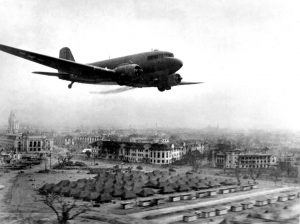
Diving Information
There is not much history on this wreck other then one would assume it was shot down by allied aircraft and crashed in the bay. Discovered in 2013, it is laying upside down on the bottom of the bay with the engines torn off, but located a few meters north of the wreck. Visible to divers is the full fuselage, still intact with wings, tail, elevators and landing gear (retracted) The nose section is mangled up, but divers can see identify the yoke, seats and some of the avionics.
Diving the wreck requires at least a Deep Divers Certification with Tec45 preferred. Rather than a moored or anchored dive, this wreckage is found using a GPS and a “shot” with a line and buoy is dropped for the divers to descend and ascend. Since the wreck is closer to Grande Island and the entrance to the bay, the visibility can typically be pretty good, except rather dark due to depth. The wreck hosts a variety of marine life.
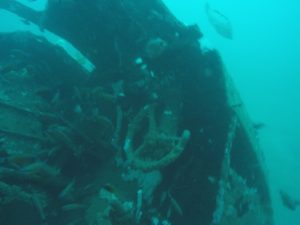




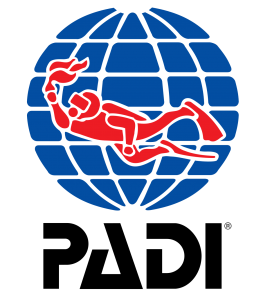

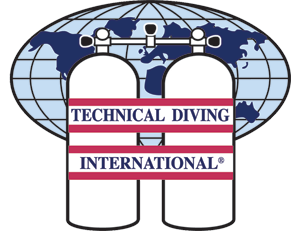


 Mangos Dive Center
Mangos Dive Center
